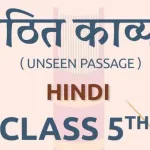Introduction
Asleep in the Valley is a touching poem by Arthur Rimbaud that reflects on the beauty of nature and the tragedy of war. It is a rich text for literary analysis and understanding poetic techniques. This collection of questions and answers will help readers and students deepen their comprehension of the poem.
Literary Analysis of Asleep in the Valley
Question: What is the central theme of “Asleep in the Valley”?
Answer:
The central theme of “Asleep in the Valley” is the contrast between the serene beauty of nature and the brutal realities of war.
Question: Who is the poet of “Asleep in the Valley”?
Answer:
The poet of “Asleep in the Valley” is Arthur Rimbaud.
Question: How does the poet describe the valley in the poem?
Answer:
The poet describes the valley as small, green, and sunlit, filled with the sounds of a slow stream and the presence of gentle nature.
Question: What is the significance of the soldier’s sleep in the poem?
Answer:
The soldier’s sleep symbolizes death, presenting a stark contrast to the vibrant and peaceful valley.
Question: How does the poem highlight the futility of war?
Answer:
The poem highlights the futility of war by showing the soldier’s death in a peaceful, natural setting, emphasizing the senseless loss of life.
Question: What poetic devices are used in “Asleep in the Valley”?
Answer:
The poem uses imagery, irony, personification, and symbolism to convey its themes effectively.
Question: What is ironic about the poem’s title?
Answer:
The irony lies in the fact that the soldier is not merely asleep but dead, contrasting the peaceful title with the tragic reality.
Question: Describe the imagery used in the poem.
Answer:
The poem uses vivid imagery to depict the lush valley, the gentle stream, and the soldier’s serene posture, contrasting with the subtle signs of death.
Question: What role does nature play in the poem?
Answer:
Nature in the poem serves as a tranquil backdrop, intensifying the tragedy of the soldier’s untimely death.
Question: How does the poet evoke emotions in the reader?
Answer:
The poet evokes emotions through vivid imagery, gentle tone, and the stark contrast between life and death.
Question: What is the tone of the poem?
Answer:
The tone of the poem is melancholic, with a mix of serenity and sorrow.
Question: How does the poem reflect Rimbaud’s views on war?
Answer:
The poem reflects Rimbaud’s anti-war sentiment by illustrating the tragic consequences of war in a peaceful setting.
Question: What do the two red spots on the soldier signify?
Answer:
The two red spots signify bullet wounds, subtly revealing the cause of the soldier’s death.
Question: How does the poet’s use of light imagery enhance the poem?
Answer:
Light imagery enhances the poem by creating a serene and peaceful atmosphere, which contrasts sharply with the soldier’s death.
Question: What is the significance of the poem’s structure?
Answer:
The poem’s structure, with its flowing lines and descriptive verses, mirrors the calmness of the valley while subtly revealing the tragedy.
Question: Why is the soldier referred to as “young”?
Answer:
The term “young” emphasizes the tragic loss of life at an early age, underlining the futility of war.
Question: What message does the poet convey through the poem?
Answer:
The poet conveys the message that war leads to unnecessary loss of life, contrasting it with the peace and beauty of nature.
Question: How does the poem’s ending affect the reader?
Answer:
The poem’s ending shocks the reader by revealing the soldier’s death, leaving a lasting impression of the horrors of war.
Question: In what way is the poem universal in its appeal?
Answer:
The poem is universal in its appeal as it addresses timeless themes of life, death, and the impact of war on humanity.
Critical Examination of Poetic Techniques
Question: How does personification enhance the poem?
Answer:
Personification in the poem, such as the sun warming the valley, adds a lifelike quality to nature, making the setting more vivid and emotive.
Question: What is the effect of the poem’s imagery on the reader?
Answer:
The imagery immerses the reader in the serene setting, heightening the impact of the soldier’s death.
Question: How does irony function in the poem?
Answer:
Irony underscores the contrast between the peaceful setting and the violent reality of the soldier’s death, enhancing the poem’s emotional depth.
Question: What role does symbolism play in the poem?
Answer:
Symbolism, such as the valley representing peace and the soldier symbolizing loss, deepens the poem’s themes.
Question: How does the poet use contrast effectively?
Answer:
The poet uses contrast between the serene natural setting and the soldier’s death to highlight the tragedy of war.
Question: Why is the stream described as slow in the poem?
Answer:
The slow stream symbolizes the calmness of nature, juxtaposing the violence that led to the soldier’s death.
Question: What is the significance of the poem’s rhythm?
Answer:
The rhythm mirrors the peaceful flow of the valley, contrasting with the underlying theme of death.
Question: How does the poet create a sense of stillness?
Answer:
The poet creates a sense of stillness through soft imagery, gentle descriptions, and the absence of dynamic action.
Question: What emotional response does the poem evoke?
Answer:
The poem evokes a mix of serenity, sorrow, and a profound sense of loss.
Question: How does the use of color imagery impact the poem?
Answer:
Color imagery, like the green valley and red bullet wounds, enhances the vividness and emotional resonance of the poem.
Latest Posts
- Step-by-step guide to download and apply for jee mains admit card 202
- Comprehensive 2025 government holidays and recruitment details for job seekers
- JEE Mains Admit Card 2025: Your Step-by-Step Guide to Downloading the Hall Ticket
- Everything You Need to Know About 2025 Government Holidays Recruitment
- Comprehensive Guide to rrb d group recruitment 2025 – Eligibility, Vacancies, and Application
- Detailed guide to nps trust recruitment 2025 vacancies, eligibility and apply process
- Comprehensive guide to hpcl recruitment 2025 notification, vacancies, and application process
- ignou bed admission 2025 complete recruitment guide with eligibility and process
- Comprehensive Guide to Indian Army Agniveer Recruitment 2025 Notification and Jobs
- Everything You Must Know About CBSE Board Exams 2025 Changes & New Rules




